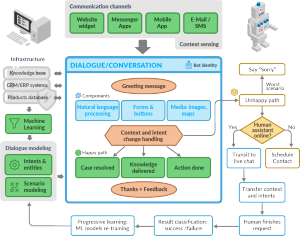Chatbot Ecosystem: Arts and Crafts of AI-powered Communication

Rapidly expanding market of chatbot solutions drives many businesses to discovery of value, benefits and competitive advantages of chatbots. In this situation companies that are planning to add a chatbot to their IT infrastructure are often not familiar with the principles and components of chatbots and so decision makers are in situation that they have to define business strategies without sufficient knowledge about chatbot ecosystem. In this article we will try to clarify these aspects and describe value and impact of each component based on our experience of building chatbots.
First of all, we would like to mention that many people (even skilled and experienced in business process management) have too simplistic vision about chatbots. There are dozens of “do-it-yourself” kits on the market, but building your own solution (dedicated to needs of particular business model) without proper understanding of the whole “chatbot universe” could end with disappointment of business and customer frustration (and what is even worse – loss of trust to your chatbot). And vice versa – understanding of key business problems and implementing a few but excellent scenarios for most demanded use cases could spread a positive rumor and raise your reputation score. So, let’s take a look deeper into this topic and reveal all hidden clues that are essential for building an efficient chatbot.
Based on our experience we came to a certain vision about chatbot ecosystem. It does not pretend to be an ultimate view, but importance of each of these aspects was proven by our own solutions:

Let’s describe step-by-step all these “building blocks” and their impact on customer experience.
Communication Channels
The most obvious impact of the last decade is what we call “smartphone revolution”. This phenomenon year by year changed dramatically habits of millions of customers, and even whole new generations. So, it is essential for business to understand which communication tools are used by focus audiences and prepare respective solutions. We find business analysis technique “user personas” very helpful for this stage, as it may reveal insights not only for chatbot implementation, but for business objectives in general.
So, first step is to understand how your business interacts with customers (existing customers as well as customers in engagement phase) and to prioritize which communication channels should be supported by chatbot: chat widget on web-site, messenger apps like Facebook Messenger, WhatsApp or Slack, chat feature integrated into your own mobile app. In some cases, even e-mail or SMS could be used, if most of your customers feel comfortable with it (although, honestly saying this segment is about to vanish).
Importance of understanding share of each channel in overall communication volume (and analysis of trends) is essential for understanding limitations that are dictated by capabilities of each channel – e.g. in SMS you can use only text of limited size, while chat widget on site can potentially use any enriched content – from buttons with predefined choices/answers up to images, videos or even map locations.
Conversation
Chatbot identity – one of important aspects that have to be considered on the earliest stages of chatbot development as it greatly defines emotional perception of chatbot. First of all, as we mentioned, it is essential to understand which audience is going to interact with chatbot – if you know that focus group belongs to particular generation, then it is worth to “equip” your bot with phrases or even slang familiar to this audience. And vice-versa: if you target a wide audience, then more formal style could fit better, although it is not worth to make a bot completely emotionless.
Another dimension to consider could be business domain – for example, bot selling fashion clothes most likely will have different “character” than bot servicing bank customers.
So, the earlier you will decide which “personality attributes” your bot should have, the easier will be the process of phrase and dialogue modelling.
However, it is not a good idea to create an illusion that customer is interacting with a live person, because it may lead to false expectations, and at the end – frustration and distrust to the brand. Regardless of “smartness” of your bot, it is worth to represent it as a “bot”, and not a “magician”.
Easy Come, Easy Go
When you decided about the “character” of your chatbot, it is worth to focus on set of phrases used to start a conversation (or attract customer) and finalize interaction (in both, successful and unsuccessful cases). These phrases are essential for impressions, that the bot delivers to customers, and these impressions greatly affect satisfaction and willingness to deal with chatbot again. Early generations of chatbots often used very simplistic or even boring phrases without variations, and this distracted many customers from trusting any chat interactions. So, if you want to avoid this “pitfall” then it is worth to think well about variety, tone and emotions of these phrases, because from psychological point of view first impression greatly defines “credit of trust” given to a digital assistant, and the end of the conversation (regardless of result) significantly impacts a chance of using chatbot again.
Over time, with proper approach and augmentation with AI techniques your bot will surely become smarter and will be able to handle more and more diverse cases/scenarios, but loosing customer trust at the early stage of bot implementation is one of worst scenarios. So, our recommendation is to test human perception of bot behavior on several focus groups before initial deployment to ensure that your bot has a nice “entrance” and “leaves the door open” even in case when customer request cannot be resolved yet. One of techniques to establish and upkeep trust to chatbots is a follow-up contact of human staff for unresolved cases which can greatly encourage customers to try using chatbots again and again.
Conversation flow
After the “greeting ceremony” it’s time to focus on the primary purpose of chatbot – the business value and the “digital brain” that provides this value. There is no common scenario for all business domains how to tailor human-bot interaction to achieve particular results, but we will describe key components, their role and purpose to show how this “puzzle” is turned into a “picture”.
The first technique that comes into play during interaction is called Natural Language Understanding (NLU) and it serves as an “interpreter” of natural human language to the data structures that can be operated by machines. Basically, this step is used to retrieve from human input three major aspects:
- Context needed for understanding of environment, area of knowledge and business process(es) where user is trying to find information or settle a request. Depending on context same words may have different meanings, and while human brain can interpret change of context instantly, chatbot needs a mechanism to identify contexts and a logic to switch them.
- Intent is literally the intention of user to perform some action with expected outcome – either settle a problem or get information or provide some data – which could be recognized and interpreted by bot.
- Entity the object or subject of action intended to be performed, which could be either plain item (e.g. product or page on website) or a complex structure with diverse attributes (like “flight” with a dozen of options to define).
And so, when NLU unit parsed user input and classified context, intent and entity it is time for business logic to analyze and process request and deliver proper response to user. On this stage a great variety of approaches is possible. Traditional solution for many years was modelling of responses by business analysts, who analyzed typical intents and entities and defined respective responses. This approach is still useful on starting stage of the business when there is not enough data about real problems or customer interest, and analysts can only forecast possible use cases. On the other side, most of businesses, which evaluate benefits of chatbots, have quite a different situation – large or even huge volume of data accumulated from earlier customer interactions, large knowledge base and product portfolio (and imagine all this data might be poorly structured). In addition, frequent changes driven by reflection to market needs and trends make analysis and classification of intents even more complicated, because even statistical instruments are not able to classify rising trends. And here machine learning comes in play, a bunch of recent technological advancements that allowed to process huge and often unstructured data volumes in innovative way. These innovations not only help to classify intents and entities, but also to reveal efficient problem-solving scenarios, saving hundreds of hours of business analysts work as well as support staff training. And periodical use of ML techniques for data analysis even got a name “continuous learning”, enabling fast recognition of changing trends and revealing stories earlier not known.
Rich Content in Communication
And so, when intent is recognized properly and the bot knows the answer or solution it is time to deliver it to user in proper representation. In simplest form of response answer is sent as plain text, and surely this is enough for most cases, and people using chat widget hardly expect more than a text, but consider the following conversation scenarios which are not so rare:
- User asks about office or nearest branch location and bot has to describe address (or provide geolocation).
- User has to choose one item of a limited set of choices (in simplest case Yes/No, but many other cases are not so obvious)
- User has to provide some data that should correspond to certain format or mask (like IBAN number or cell phone number in international notation or enter a password that has to be secured).
Each of these cases can be settled with a text answer and text input from user, however in means of user experience cost of this “simplicity” could be too high. On the other hand, we can greatly enhance user satisfaction by providing augmented content – map fragment with link to map service for quick navigation start, buttons with text or graphical illustration of choices (e.g. product colors), or input box which ensures correct input of formatted data. Of course, some communication channels have limited capabilities, but this is just a motivation to think deeper about possible level of service quality that your solution can deliver to customers.
Decision making
As chatbots are used to handle tasks of different complexity, they need to achieve respective grade of “smartness” from developers and business analysts. For simpler scenarios it is enough to provide an answer for the recognized intent. When user request or action needs more attributes (e.g. input of phone, email or bank account) then in response to user request a rule-based scenario is launched to specify and complete request properly. In more complex scenarios it might be necessary to “sense” context and entities related to these scenarios, and at the same time follow user input to identify switch to another context which is common for natural conversation. Examples of such scenarios could be:
- booking a flight and definition of flight properties in any order comfortable for user, occasionally switching to inquiry about weather forecast in the destination location.
- preparing a bank payment and in meantime requesting cash balance on different accounts.
Capability of handling user input without predefined scenarios is a characteristic of “conversational chatbots” (which we call “generation 3”), and while delivering superior user experience, requires significantly more engineering effort (in particular data science approaches).
Success of Scenario
It is natural for majority of humans (and businesses) to think positively about future, and often this leads to a vision that “chatbots can handle everything”. However, we should add a bit of imperfection to this point of view. Usually success of chatbot is measured by number of successfully resolved cases – in different scenarios these usually are: “requested action done”, “problem resolved” and “knowledge delivered”. This is quite objective measurement because it can be reflected with a “line in your budget”. However, businesses should consider real impact of chatbots from a total volume of customer requests, keeping in mind the following “gears” between customer and business:
- first of all, not every customer is willing to deal with chatbot, many people still prefer to deal with humans (even despite the fact that chatbots are available 24/7 unlike 8-10 hours on working days of usual support service)
- NLU engines are not perfect yet, and even for English language proper recognition of context and intent is often complicated by ambiguous contexts, use of slang and even typing errors, so understanding of user intent is not guaranteed, even assuming that bot knows the answer for question that user means. When speaking about languages other than English it might require even more effort of business analysts to care about regional differences and specifics (like we had in our experience with German language).
- chatbots operate with cases they know (either from rules defined by business analysts or from machine learning), so anyway there are specific or rather complex requests which cannot be handled (or design of such scenarios is simply too expensive for implementation).
In summary, efficiency of chatbots should be realistically estimated as a share of chatbot-resolved requests to all customer requests (at least for particular domain/process/problem). Success factor could greatly differ across business domains, and it would be overoptimistic to treat chatbot as a “silver bullet” that will guarantee success of the entire business process, however big businesses can benefit even from a few percent of customer satisfaction increase.
On the other side, analysis of chatbot logs can deliver additional value to the business – understanding which of the core processes are not efficient or generate too many support requests, to invest in particular process optimization.
When Something Goes Wrong
Regardless of implementation, there are no “oracles” among chatbots, and sooner or later users may ask a question which cannot be answered by chatbot. For this case the minimum set of features should be:
- prepare a number of variations in expressions that describe inability to handle request, to sound more natural
- when user decides to end conversation – provide a possibility of feedback or contact information
- store conversation log for later analysis (in particular – by machine learning algorithms).
However, where possible, user experience could be enhanced with additional instruments that motivate user to stay in touch with the business until desired result is reached:
- possibility to transit to live chat with human support staff when chatbot cannot handle specific request
- as bots are designed for 24/7 use and human support staff is not always online it might be very helpful to use bot to schedule live contact within working hours in user-preferred channel.
Chatbots as Augmentation of Human Staff
When transferring chat to human an additional benefit could be transfer of recognized context and intents of user along with chat history, to enhance situation awareness and reduce response time. On this stage bot can also assist humans by processing inquiries on internal knowledge base (like integrated search engine) which cannot be exposed to public, thus helping humans to find solution/answer faster.
Another scenario which one can imagine for chatbot is acting as a personal assistant and send reminders to personnel (e.g. in corporate chat platform) about scheduled appointments.
Continuous Improvements
When conversation ends, it does not mean that the journey is over – any data collected from chat outcome is a new experience, that has to be carefully stored, classified and analyzed. Regardless of actors in this process – chatbot, humans or both, every drop adds something to the data lake which could become a valuable source of information if used properly. And here we come to yet another benefit of artificial intelligence and machine learning – an ability to process large volumes of data and produce outcome and conclusions with unprecedented speed and cost compared to traditional approaches. This kind of data processing can efficiently reveal trends and changes, recognize new intents and entities and serve as an efficient instrument for proactive reactions of business in the changing environment. Regular or even automated analysis of incoming data combined with formerly accumulated knowledge is called “continuous learning”, and it becomes extremely important for fast-changing markets with high level of competition.
Dialogue modeling
For businesses chatbot implementation usually starts with identification of known cases based on accumulated statistics, knowledge and priorities. Afterwards, continuous learning helps to improve chatbot gradually to face new challenges and match new requirements. But the fact of knowing use cases and even knowing answers/solutions for these cases is not enough to build quality service comparable to human interactions. Recognized and classified requests should get a proper response, and here key stakeholders from business side are business analysts and subject matter experts as they have deepest knowledge about business processes, terminology and language patterns specific for business domain. So, besides of identification of cases (analytically or through learning) we believe that business should have instrumentation to model case resolution scenarios by their own skilled professionals, and to involve developers and data scientists only in cases that require specific knowledge or approach.
Therefore, we consider dialogue modeling environment (instrumentation) as an essential component of chatbot solution, and while initial deployment of chatbot can be done by software engineers, long-term success is possible only when business experts are able to model and adjust scenarios on their own.
Crafting your Chatbot
Despite of many references above on using chatbot in customer support, there is a number of uses which could have even greater value for business:
- assistance in customer engagement on web-site or other channel, by analysis of user behavior and encouraging users to interact with bot and share their interests, habits and preferences and then generating lead for sales and marketing departments and transition to live chat with humans where possible
- bots can also perform a role of robo-sellers by analyzing customer requests and finding appropriate products or services; this role could also be a part of support scenario to offer upsell products in some cases
- business scenarios that require data collection from customers such as surveys, questionnaires, inquiries and other forms of customer-to-business data delivery in most cases can be elegantly resolved with chatbots, especially considering that chat is quite natural communication method of younger generations and significantly lowers cognitive pressure compared to long and complicated web-forms.
In either of scenarios mentioned above (and many others that deal with enterprise data storages) backend of the bot solution has to be integrated with other in-house services and platforms to deliver desired level of personalized service. These integrations should be revealed and qualified at the very early stages of implementation in order to understand realistic implementation roadmap and possible blockers. Implementations of such “connectors” to CRM/ERP systems, knowledge bases and other resources is usually done via service APIs, and enterprises have different level of readiness for this step, and this readiness should be evaluated carefully.
Balance of Benefits and Risks
Besides of many opportunities offered by chatbots one should not forget about risks, especially in case of large enterprises with strict security regulations (both internal and domain-wide like in banking/healthcare sectors). Interactions with registered customers require customer authorization and often access to their data, and bots may use interactive elements in user interface to collect customer data and represent replies that contain their private data – so enterprise has to define data privacy policy of chatbot and ensure that this policy can be enabled in all desired channels. Data privacy can often define limitations on technological platform and infrastructure where chatbot is going to be deployed. While for smaller enterprises cloud-based SaaS/PaaS solutions could be a quick win, large enterprises in strictly regulated environments would rather prefer on-premise setup to guarantee only internal data exchange to reduce possible risks and ensure full control of process.
Summary
At Abto we prefer service-oriented approach focused on business objectives of our customers, so we would gladly consult your business about benefits which can be gained through implementation of chatbot and offer a roadmap of feature implementations to maximize value delivery on each step. According to our vision one of the key achievements of chatbots should be trust and satisfaction of your customers, which this trust should be gradually and continuously improved to reveal all benefits of recent technological advancements.




